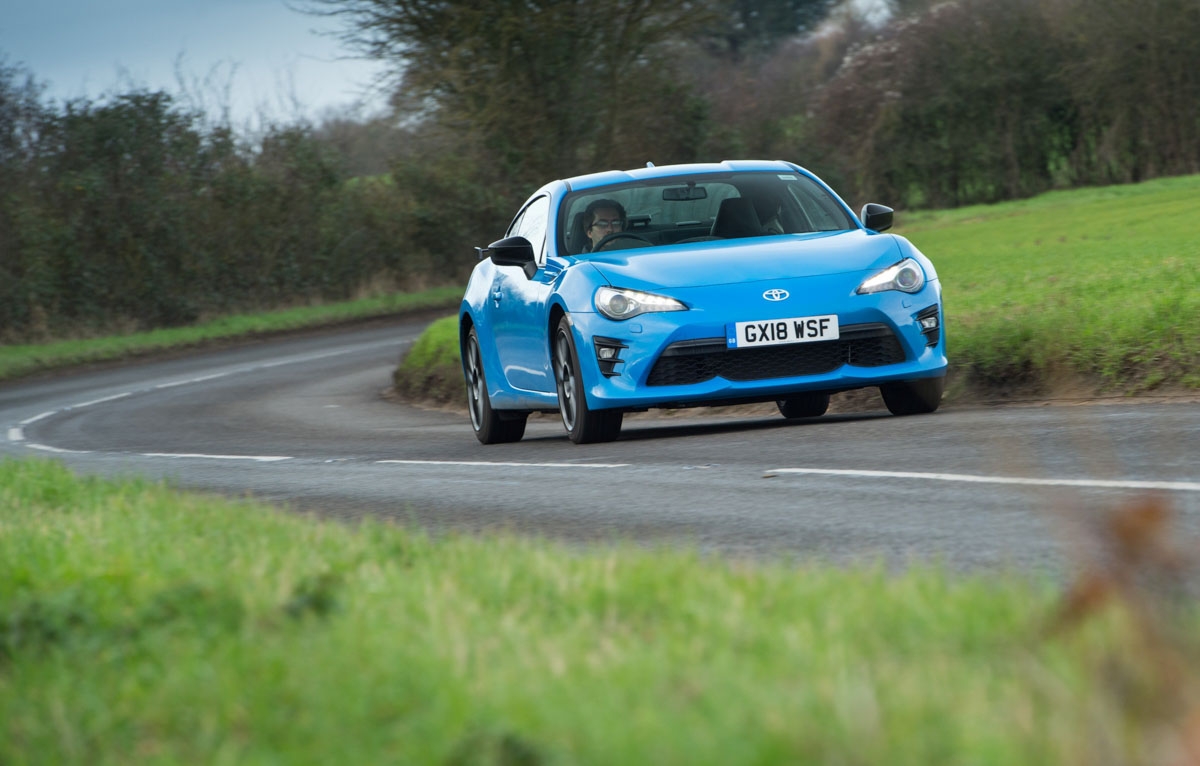Increasingly rare accessible rear wheel drive thrills
| Fun at sensible speeds, great driving position, old-school values | |
| Wants for a bit more power, low-grip Primacy tyres an acquired taste |
Ask yourself this: what do I really need from a car in order to be able to enjoy it on the road? If the answer is leather seats, parking sensors and a posh badge on the bonnet, then the Toyota GT86 isn’t for you.
If, however, what that matters is three pedals, reactive steering and a sweetly balanced chassis, the GT86 is worth a test drive at the very least. The steering accuracy and control weights are supremely well judged, while the boxer engine’s 197bhp and skinny tyres mean the chassis can almost always be teased out of shape. Crucially, in the world of 300bhp hatchbacks, it’s also a car you can get stuck into driving on public roads without fear of losing your licence.
Rarely does something in the motoring world feel ‘just right’ and while the GT86 isn’t without its issues, it comes very close. The 0-100kph sprint doesn’t set the world alight, but to compensate that you spend a lot of time in the GT86 with your foot flat to the floor and using the engine to its potential an increasingly rare experience in modern performance cars.
Back 2017 the GT86 has received a facelift, and a couple of special edition variants have arrived since, with no more power but some worthwhile extra features. Prices now start at $35,540. Admittedly, the changes are modest, but include upgraded dampers, a stiffer bodyshell, a better-appointed interior, more technology and several subtle but effective exterior design revisions. What hasn’t changed is the car’s mischief-making nature, for which we’re grateful.
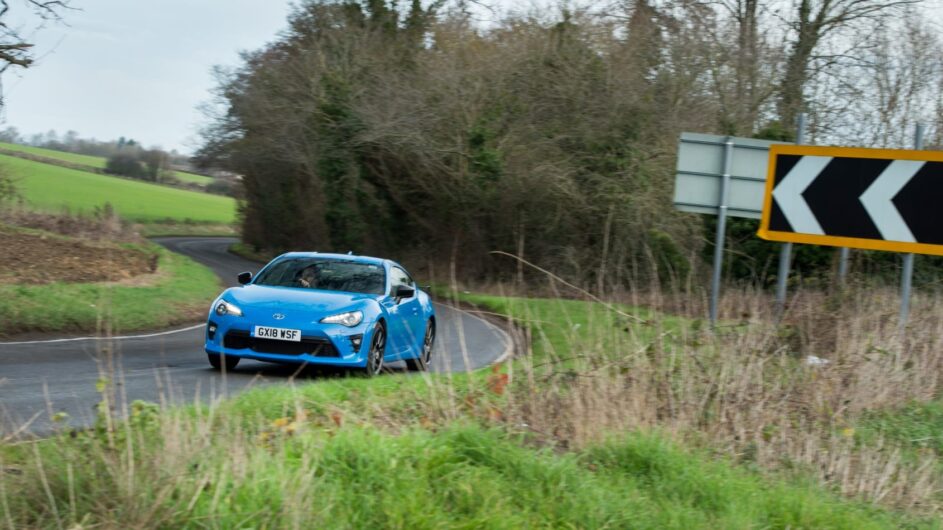
Prices, specs and rivals
The GT86 is currently available in three different grades. At the bottom is the standard GT86, starting at $35,540 and offering 17-inch alloy wheels, a Toyota Touch 2 multimedia system, and goodies like keyless entry. It’s starting to look a little pricey these days, but then the average hot hatchback is now over $40,000, so perhaps $35k isn’t so bad for a rear-drive sports car on a bespoke platform.
Above this is the GT86 Pro, at $37,035. The extra dosh doesn’t get you a new set of wheels, but does trim the front seats in leather and Alcantara, and lets you warm your posterior too, while automatic LED headlights and a rear spoiler join the party. The latter we’ve never been sure about – the GT86 styling is best unadorned, we reckon.
Next up the food chain is the current special edition, dubbed (in rather long-winded fashion) the $37,745 GT86 Club Series: Blue Edition. As the name suggests, it’s blue – Electric Blue specifically, and one of the best colours we’ve seen on a GT86. The specification includes the same machined-finish 17-inch wheel design, plus a black rear spoiler and black door mirror caps. It’s at its best though with the optional Performance Pack, as on the car pictured – there’s a more subtle 17-inch alloy design, Sachs performance dampers and Brembo brakes. It adds $1900 to the price.
Those seeking more from their GT86s’ though can reap the benefits of a thriving aftermarket. The full fat Litchfield GT86 equipped with a raft of suspension upgrades and most notably a supercharger – not the only forced induction route there are turbo kits too. Retaining the car’s naturally aspirated state does not totally negate any gains, a remap and new exhaust system can liberate more performance and massage the torque curve.
Chief amongst rivals is Mazda’s MX-5 RF powered by the range-topping 2-litre, which was refreshed for more power in 2018. The little roadster is a hoot to drive but loses out to the GT86 when you go in search of that last tenths of performance, where body roll curtails your confidence and thus progress when you really push. A used Porsche Cayman is certainly worth considering too; more recent 718 Caymans even have four-cylinder boxer engines like the GT86…
And the GT86 has a cousin, in the form of the Subaru BRZ (slightly cheaper at $35,200). Its suspension is tuned very slightly differently to the ’86, and its styling is arguably slightly more attractive after each had a mid-life restyle, while it’s Subaru that created the cars’ boxer engine. It flies under the radar a little – Subaru doesn’t seem to market it as heavily as Toyota does the GT86 – but being nearly identical, it’s still fantastic fun.
Performance and 0-60 time
The Toyota GT86 is a car that more often than not feels like it needs just a little bit more when it comes to performance.
The 7.6-second 0-100kph time (unchanged for the facelifted model) is fine on paper but on the road the GT86 feels slower than you’d expect for a car with such an emphasis on driving. The more pressing issue, however, is how hard you need to work the engine to reach the quoted 197bhp and crucially, the meagre 151lb ft of torque produced at a sky-high 6400rpm.
Indeed, with the car’s true performance on offer only close to the red line, you need to work the engine hard to extract the flat-four engine’s potential. The commotion will come as a surprise to anyone used to modern four-cylinder turbocharged units – the sound is industrial and sometimes even harsh down low, and offbeat at high revs. But befitting the boxer design it’s also free of vibration, and will happily spin to the limiter without issue, prompting a beeping to remind you another gear is due. There’s a satisfying induction note in the mid-range too, which perhaps offsets slightly the slightly flat feeling lower down the rev counter.
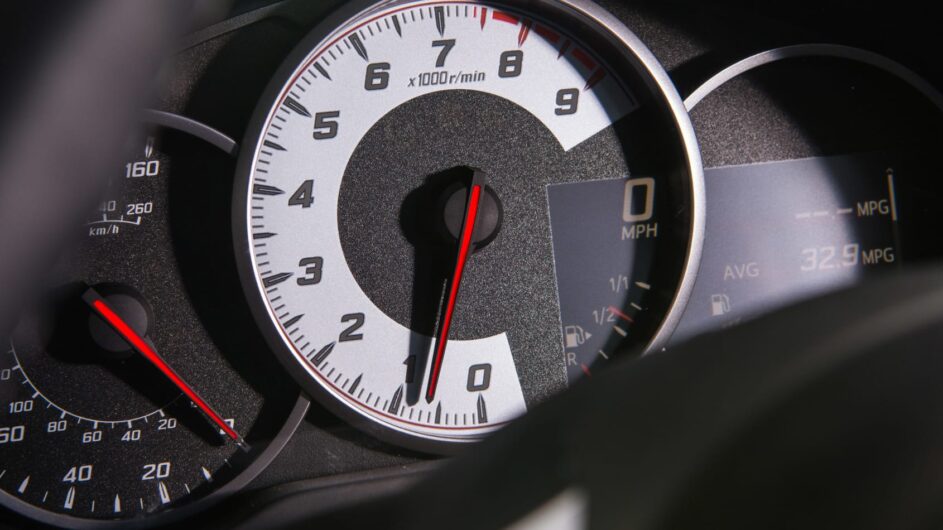
It does mean that exploring the car’s limits requires a committed driving style. We’re not saying the GT86 needs another 200bhp, just a broader power band and another 50bhp and 50lb ft, which would alleviate some frustration and imbue the driving experience with a little more gusto and verve.
Conversely, the GT86 proves that you don’t need to be risking life, limb and penalty points in order to enjoy a car. While you need commitment to enjoy the full reach of the engine, you’re also not travelling obscenely quickly if you do so. It’s a car that proves that sometimes, chassis balance and the sensation of pushing a car to its limits are more valuable than all-out straight-line speed… though a little more of the latter wouldn’t go amiss.
Engine and gearbox
The GT86 uses a Subaru-derived (but with Toyota-designed direct injection), naturally aspirated DOHC 2-litre flat-four boxer engine. It’s a long way from being the car’s crowning asset, with less character in its buzzy cylinders than the warbling turbocharged boxers of Subaru’s rally-refugee WRX STI.
The engine has a slightly unpalatable, industrial quality to it, with a thrashy and strained sound down low and some curious noises higher up. It does, however, like to be revved – indeed, it needs to be revved – and works nicely in tandem with the excellent six-speed manual gearbox. There’s a great mechanical connection with the manual ‘box, with a precise feel matched to a light shift. It can be a little obstinate when cold, but it’s among the best out there once the fluids are warm. The combination makes sense as a powertrain, but the engine’s utilitarian approach to delivery makes the GT86 feel less special that it perhaps should.
As for the six-speed auto, it removes the mechanical interaction that makes the manual car such a joy. Performance also drops, which is a particular problem given that, for the most part, it’s at a premium in the GT86.
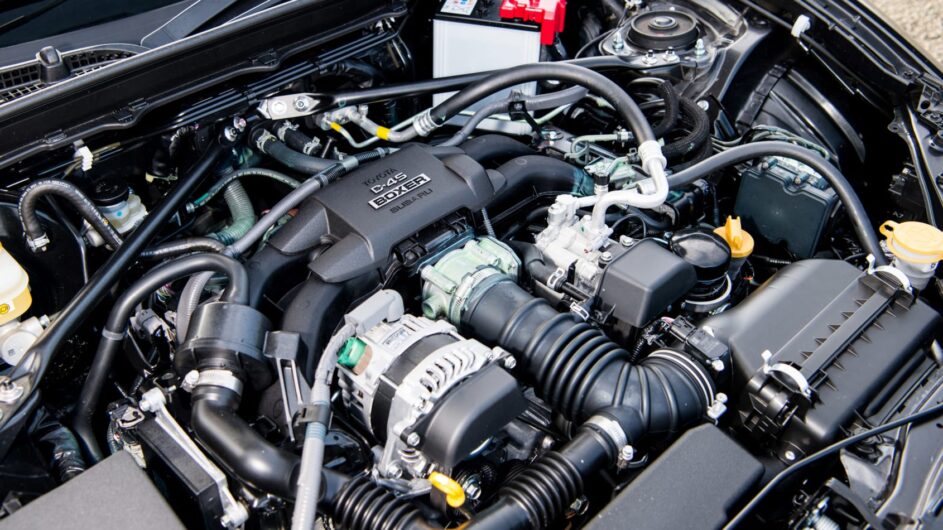
Unlike modern turbocharged engines, you really need to utilise the entire rev range to extract any sort of performance from the 2-litre boxer – 197bhp is on offer at 7000rpm (the limiter is at 7400rpm), while the modest 151lb ft of torque only arrives 600rpm earlier. As for the electronic throttle, it has been mapped to make the engine feel more sprightly at lower revs, but don’t let that fool you – you need to drive the GT86 hard to get at the power it develops.
While it might not be a particularly smooth or sweet-sounding engine, it does feel endlessly durable and tough, which means you don’t think twice about hammering it all day long. For many, the effort in extracting the car’s performance is also part of the reward. It’s just a pity the aural rewards aren’t greater – this is no howling Honda VTEC.
Ride and handling
Whatever we might say about the GT86’s interior, it gets one thing very right: the driving position. Low-slung and with plenty of adjustability in the seats and wheel, just about everyone, no matter how big or small, should find a suitably comfortable and supportive driving position.
When you combine the innate rightness of the driving environment with fantastically direct steering, a great gearshift action and pedals ideally placed for heel-and-toe shifts, the GT86 becomes a car that shrinks around you, connecting you to the road via well-balanced control weights and a low hip-point.
You also get the feeling when sat in the GT86 that the centre of gravity is practically scraping the tarmac – Toyota says it’s lower than you’ll find in a Porsche Boxster. The flat-four engine is low and compact, while the minimalist approach to the cabin (though the facelifted 2017 model has in fairness upped overall ‘plushness’ a little) meant Toyota was able to keep weight low, at 1222kg.
For suspension, the GT86 uses MacPherson struts at the front and double wishbones at the back. Both the standard-fit Showa dampers and the optional Sachs dampers have been revised for 2017 in an attempt to inject some more refinement, and Toyota says that while both pieces of hardware have been improved, the discrepancy in performance between the two has also been shrunk significantly – a good thing for buyers of the base model.
Nevertheless, the ride can still be harsh at low speeds (it’s better on the Sachs units), but it stops well short of being truly punishing – several hot hatches are less forgiving. The car’s low stance helps reduce any tendency to pitch and roll, and to this end the 2017-onwards models have thicker anti-roll bars than before, a stiffer bodyshell, and the transmission cross-member has also been reinforced.
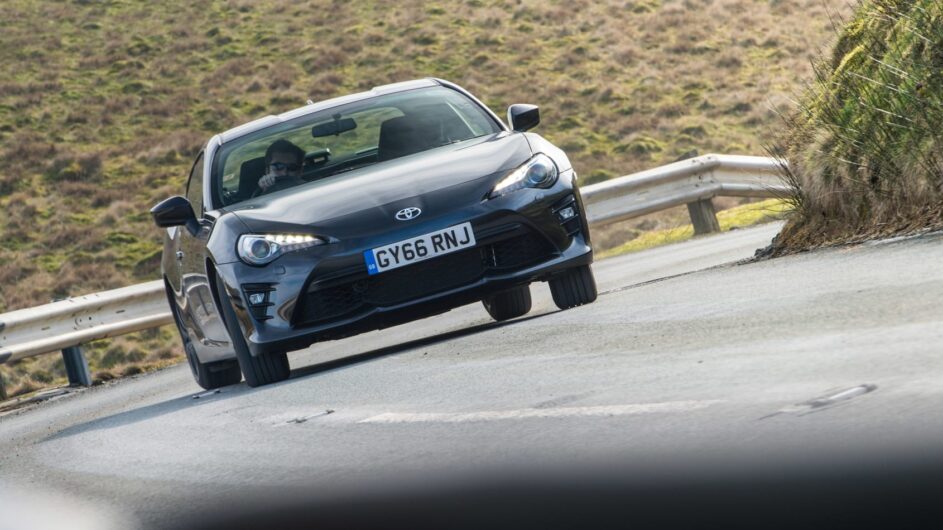
The GT86 starts making sense when you start to push it. The grip limit of the rear tyres arrives much sooner than you might expect, but the traction control is especially keen to intervene, so beginners need not worry. However, for those who are no longer beginners, from 2017 there’s a ‘Track’ mode. This sets the traction and stability control system to minimum intervention, giving you plenty of freedom to play with the rear axle and enjoy the car’s sweet balance but with the ultimate reassurance of a safety net. Indeed, with (very) generous use of the throttle, the car will hold big angles before the electronics clamp down on the fun.
Many will still prefer to have all the safety systems completely off, though, such is the balance and predictability of the GT86 chassis. You’ll have to work it to get the car dancing, largely thanks to the lack of torque, but the trade-off is that you’ll likely do so within the speed limit. In the wet, you need to be a little more judicious as the GT86 can become unruly with marked shifts in momentum, especially with the VSC switched off.
The standard-fit low-rolling-resistance tyres, meanwhile, tend to deform quite markedly in hard cornering, which blunts steering response somewhat. While the low-grip tyres give the car an adjustability and sense of fun at medium and humble speeds, the consequence is that in faster corners confidence is in short supply.
The GT86 is perhaps the most democratised rear-wheel-drive performance car on sale, but as for the accessibility of its driving thrills, more experienced drivers will quickly want more grip and precision in the chassis, better body control and, of course, more power.
Comment
‘Try a lift on turn-in and the chassis shows more of its playfulness, the rear arcing wider than before. Stay on the power and it’ll oversteer nicely, progressively, with none of the snap-back exhibited by the Subaru BRZ. It still hasn’t got the power to maintain lurid second-gear slides but it’ll slip through third-gear turns with composure and slow-mo predictability.’ Jethro Bovingdon
L/100km and running costs
The GT86 is rated at 8.7L/100km according to new WLTP figures (196g/km CO2), and this figure should be well within reach. You’ll see less on a track, but on a motorway run the low rolling-resistance tyres, low weight, slick aerodynamics (it has a coefficient of drag of 0.27) and frugal engine all conspire to return figures upwards of 7L/100km – more than welcome for those long trips on the way to entertaining roads or a trackday.
As for running costs, the GT86 is all about value for money. Porsche premiums need not apply here, which is well worth considering if you’re weighing up a GT86 against a used early Cayman or Boxster. The car comes with Toyota’s five-year warranty, which is enough to see out any ownership period for those who are considering buying on finance, while the Michelin Primacy tyres seem to last forever (maybe even too long, for those waiting to swap to something stickier!). Being relatively light and not over-endowed with power, consumables like brakes should last longer than on the average hot hatchback, too.
Interior and tech
The GT86 is definitely not going to win any awards for its interior, though things have improved for the 2017 facelift. Despite having immensely supportive, comfy and attractive seats and suede on the dash for that flocked-rally-car look, the inclusion of fake-carbon trim and hard plastics sets a distinctly low-rent tone.
But the focus here is on driving. The GT86 has a superb driving position (anyone over ten years old can forget sitting in the back, though) and the new steering wheel has been painstakingly designed to angle the driver’s arms inwards, which Toyota says ‘promotes a sportier feel’. And it does. The GT86 gets it right elsewhere, too, and though it can take a bit of adjustment, the pedal-seat-wheel-gearstick relationship can be perfectly arranged for a comfortable but engaging drive, and it often feels as though your backside is sat on the rear axle.
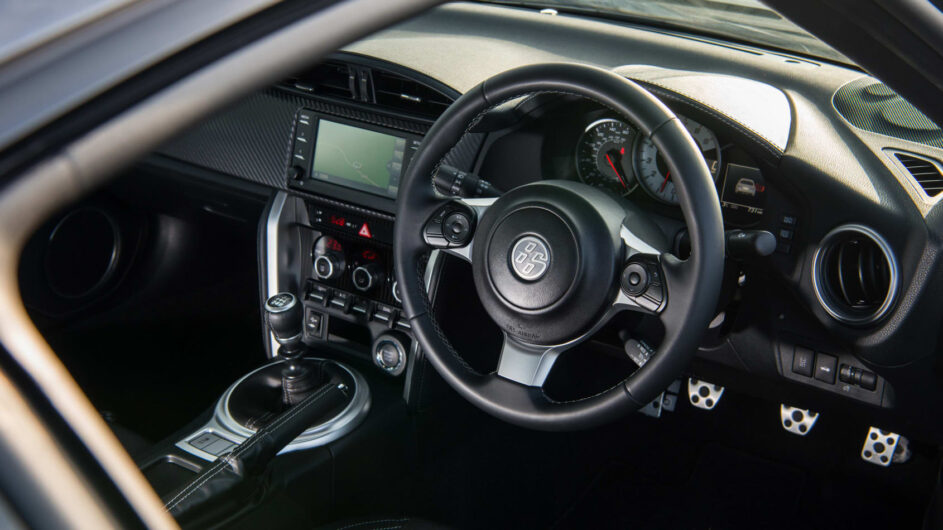
The instrument cluster sets the right tone, too, with a clear central rev counter that puts the engine’s 7000rpm sweet-spot dead centre (it has been reoriented for 2017). To its right is a 4.2-inch colour TFT screen that can display journey details, coolant temperatures, power and torque curves, lap time, a stopwatch and even G-force monitor (all very R34 Nissan GT-R).
The satnav has also been updated, and can be optioned with three years’ free map updates and access to live road-traffic information, Google and even Twitter. Unfortunately, it’s far from being one of the better systems on the market, and entering an address seems to take an age. Luckily, the fact that Toyota is still using a double-DIN fitment for its system means there’s a whole aftermarket of improvements out there; we’d opt for something with Apple CarPlay or Android Auto for a start.
Design
For 2017 the GT86 gets a host of aesthetic updates but nothing major. After five years on sale, a tightening up of the car’s appearance was inevitable and is generally welcome. The biggest change is to the front bumper, which is now set lower and wider and features two abrupt ‘teeth’ set into its lower jaw. That we’re not so sure about.
The black moulding at the rear is a better effort though, housing the exhaust tips and an enlarged diffuser element, which now extends low enough to hide the exhaust silencer. The most noticeable amendment, however, is probably the new rear wing, which comes as standard on Pro models and replaces the slightly odd spoiler tacked to the boot lid of the original car.
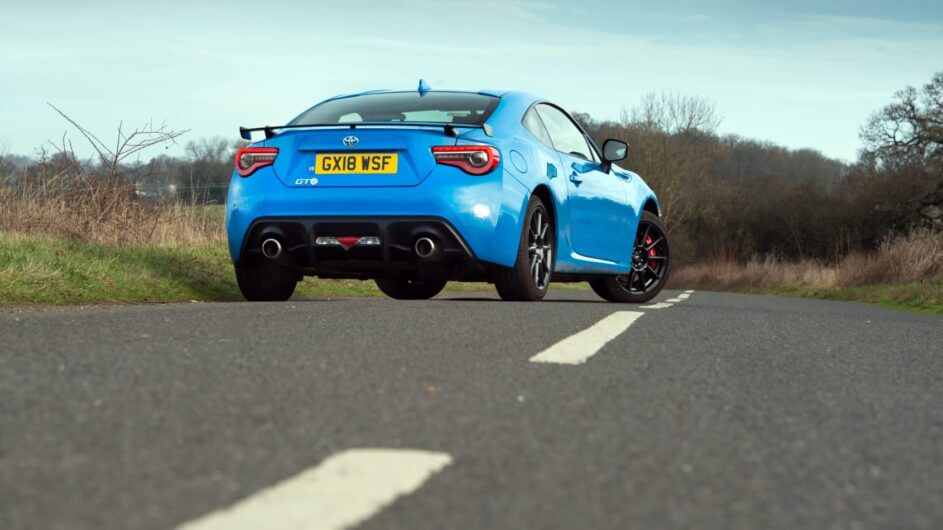
Its body-coloured endplates are in contrast to the black surface, and Toyota says the new bodywork helps control body roll and increases stability at high speed (top speed in 225kph).
Also new are 17-inch, 10-spoke alloy wheels that are machine-finished for a two-tone effect, while Performance Pack cars get a more subtle (and to our eyes, more attractive) multi-spoke design. The fresh headlight and tail lights, meanwhile, are sharp LED units that are fantastically piercing and probably do most to bring the facelifted model up to date. The tail lights in particular are an improvement over the Fast-and-Furious-era clear lenses used beforehand.
This article originally appeared at evo.co.uk
Copyright © evo UK, Dennis Publishing

